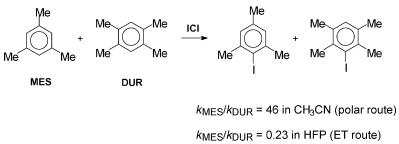Aromatic iodination: a new investigation on the nature of the mechanism†
Abstract
Following a suggestion by the late Lennart Eberson, we have employed the ICl–HFP (HFP being

* Corresponding authors
a Dipartimento di Chimica and Centro CNR Meccanismi di Reazione, Università ‘La Sapienza’, p. le A. Moro 5, Roma 00185, Italy
b Centrul de Chimie Organica, Spl. Independentei 202-B, 76250 Bucuresti, Romania
Following a suggestion by the late Lennart Eberson, we have employed the ICl–HFP (HFP being

 Please wait while we load your content...
Something went wrong. Try again?
Please wait while we load your content...
Something went wrong. Try again?
M. Fabbrini, C. Galli, P. Gentili, D. Macchitella and H. Petride, J. Chem. Soc., Perkin Trans. 2, 2001, 1516 DOI: 10.1039/B103758G
To request permission to reproduce material from this article, please go to the Copyright Clearance Center request page.
If you are an author contributing to an RSC publication, you do not need to request permission provided correct acknowledgement is given.
If you are the author of this article, you do not need to request permission to reproduce figures and diagrams provided correct acknowledgement is given. If you want to reproduce the whole article in a third-party publication (excluding your thesis/dissertation for which permission is not required) please go to the Copyright Clearance Center request page.
Read more about how to correctly acknowledge RSC content.
 Fetching data from CrossRef.
Fetching data from CrossRef.
This may take some time to load.
Loading related content
